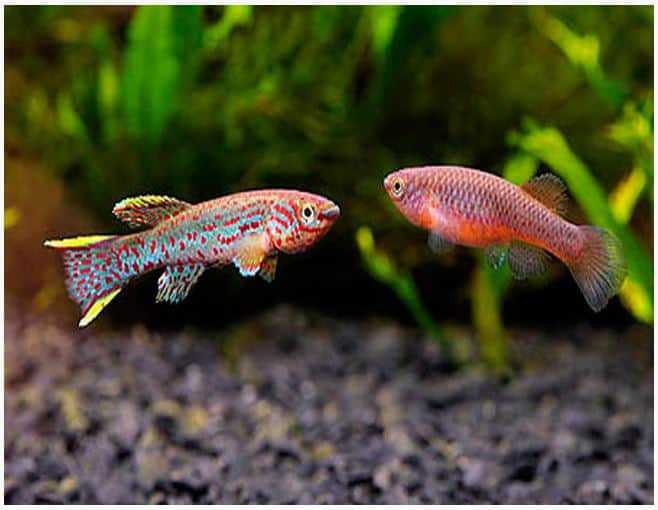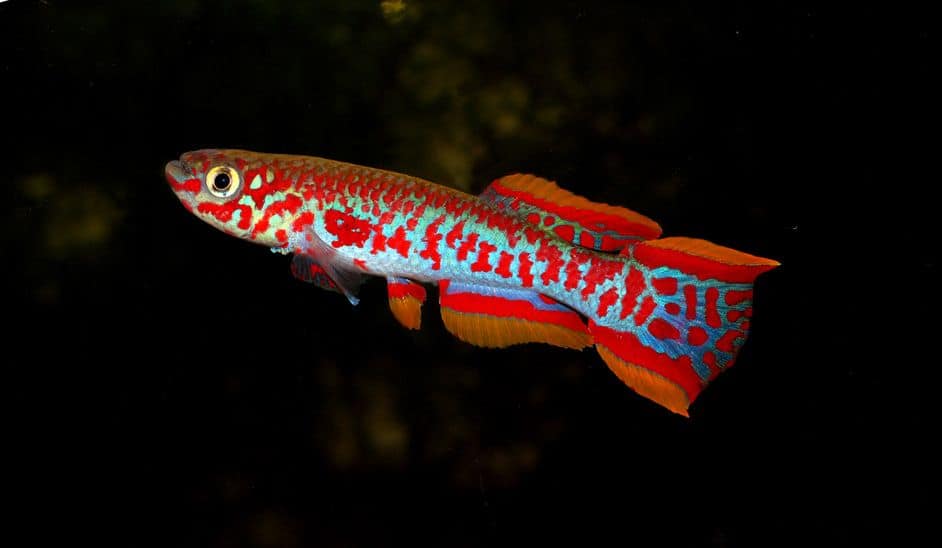Do you want to add some color to your Freshwater Tropical Fishtank? Then look no further than the beautiful Gardneri Panchax Killifish (Fundulopanchax gardneri).
Their name is derived from the term Killy which is from the Dutch word meaning ditch, channel or creek like where most Killifish are found in the wild.
Many beginners stay away from these fish due to the name, they think they must be aggressive or Killers but actually these beautiful fish make perfect community fish although they can be semi-aggressive and the other tank mates will need to be able to hold their own.
The male species of Gardneri Killifish are the most beautiful, with blue-green and red spots running the length of the body. The ends of the dorsal, anal and caudal fin are fringed in bright yellow.
The females are not as brightly colored, they have lots of small brown spots running the length of the body.
Read our Complete care guide to Gardneri Panchax Killifish (Fundulopanchax gardneri) where we will give you all the information so you can decide if you should buy some of these fish for your home aquarium.
| Scientific Name | Fundulopanchax gardneri |
|---|---|
| Family | Aplocheilidae |
| Size | 3” Max |
| Tank Size | 5-10 Gallons+ |
| Care Level | Easy |
| Temperament | Semi-Aggressive |
| Diet | Carnivore |
| Origin | Captive Bred- Africa, |
| Cost | $7.99 |
Table of Contents
Origin
These fish was originally discovered in 1911 by the Belgian zoologist George A. Boulenger. The species is named in honor of the first person to catch and collect one Mr R. D. Gardner who reportedly collected them at Okwoga on a small tributary of the Cross River in Nigeria.
The Killifish can now be found in Cameroon and Nigeria, but mainly found in water holes, streams, and marshes in Africa.
In the wild, these amazing fish can survive in very small water traps. Some are as small as an elephants footprint. Their eggs can lay dormant in the soil until the rains come and fill the hollows and small holes in the ground with water. The eggs then hatch and Killifish start to grow and live. See the video below, it’s an amazing story.
They first came onto the aquatic market for sale in 1913 and are still highly sort after fish today. It’s no surprise when you see their magnificence in real life. Look at the details patterns and colors and you’ll understand why for the past 100 Years they have been the star attraction in many home aquariums.
The only bad thing about Killifish is the availability. Even though there is now a strong captive bred program in fish farms around the world but mainly in the far east, they are still hard to come by.
Many serious collectors prefer to travel to Africa and collect their own.
These fish have been known to live in very shallow water and jump from stream to stream. So keeping a very tight lid on your aquarium is advised. They can escape from the smallest gap. You have been warned!
Currently, six subspecies of killifish are recognized, each with one to several locality variants available to the hobbyist. Plus, at least one man-made strain and a mystery strain that has appeared in some homes and shops. Very little is known about this Killifish.
Tank Requirements
A tank size of 5 Gallons is fine for these fish as long as you have plenty of plants. They prefer a planted aquascape type design and thrive in softer water on the acidic side.
Feeding
In the wild these fish feed on Crustaceans and small insects. In the home aquariums, they will eat dried flakes, pellets and dried carnivorous foods like Brine shrimp and Blackworms, bloodworms.
If you are planning on breeding F.Gardneri then you’ll need to give them a good variety and plenty of protein-rich live foods. This will encourage breeding and give them the nutrients they need to spawn.
I also feed mine chopped up garden worms. Make sure they are finely chopped, washed and clean from earth. Don’t feed them live food too often in your main community tank. Only when breeding them, otherwise just give them some live food along with your other fish once a week.
If you do successfully breed Fundulopanchax gardneri then you’ll need to feed them newly hatched brine shrimp or micro worms until they are big enough to take dry foods.
If your fish becomes ill or starts to show unusual behaviors then read our complete guide to diagnosing and treating many of the common diseases in our complete guide.
Sexing
Sexing is relatively easy, Males grow larger, and are more brightly-colored and develop more-extended fins than females.

Breeding Killifish
Many of the writers here at Fishkeeping Forever have successfully bred Killifish and all of us agree a small and simple setup works well.
Here’s our suggestion for breeding these fish.
Use a small 10 Gallon tank with soft substrate 1-2mm deep and some rocks or Bogwood with Java moss attached. Add some floating plants and plant one side of the tank heavily offering some security.
Temperature between 60-70 Deg Fahrenheit with bright lighting.
Select a good pair from your community tank and add to your breeding set up. Feed them on rich, protein-packed live food for 2-3 weeks. After a couple of weeks remove the pair and add back to your main tank.
Within days you should see young fry starting to emerge from the Java Moss.
Feed on newly hatched brine shrimp and microworms ( Bloodworms )
We find this method provides good results with small but adequate numbers of fry. Feed regularly 3-4 times a day in small portions until they are big enough to add to your main tank or sell/give away to friends.
Other Types of Fundulopanchax genus
- Amieti
- Arnoldi
- Fallax
- Filamentosum
- Mireabelis
- Puerzli
- Robertsoni
- Rubrolabialis
- Sjoedstedti
- Walkeri
Suitable tank mates
These fish are can live with many other peaceful aquarium fish but the can be semi-aggressive and will get along with lots of freshwater community fish of similar size and nature. Their brightly colored fins will attract attention from more aggressive fin nippers.
Heres a list of suitable tank mates:
- Tetras
- Barbs
- Danios
- GloFish
- Siamese Algae Eaters
- Corydoras
- Dwarf Gouramis
- Clown Loach
Should you buy some Fundulopanchax gardneri?
To answer this question you have to think about the type of fish you’ll be keeping with these Gardneri Panchax Killifish. If you want to add larger more aggressive fish then NO don’t buy some, they can hold their own with larger fish but they prefer a more peaceful life.
However, if you want an easy to keep, breed and feed fish that is colorful and stunning to look at, then YES go out and buy some.
I have kept them for many years and love them!
Many of the writers on our website have either got some or have kept them before moving onto Marine fish or Larger more aggressive fish like Oscars.
They are relatively cheap to buy and keep. The only difficulty is finding a nice breeding pair or small shoal to add to your tank. They get purchased very quickly when the aquarium store or pet store gets them in stock.
Tell your local store that you would like some so they can set them aside for you next time they get some in stock.
Alternatively, join a Fish Keeping group on Facebook and ask members if anyone has any for sale. We have our group, click here to join.
amzn_assoc_placement = “adunit0”;
amzn_assoc_search_bar = “true”;
amzn_assoc_tracking_id = “fishkeepers-20”;
amzn_assoc_ad_mode = “manual”;
amzn_assoc_ad_type = “smart”;
amzn_assoc_marketplace = “amazon”;
amzn_assoc_region = “US”;
amzn_assoc_title = “My Amazon Picks”;
amzn_assoc_linkid = “9afaa76933c8596e7df1f7963cd39120”;
amzn_assoc_asins = “B00025Z6YI,B00025K0XA,B0002DK91U,B005F34LPW,B00CXDRDRA,B00CRIDDCU,B005QRDDWY,B0002DJ7ZY”;
References Used
https://www.fishbase.de/summary/Fundulopanchax-gardneri
http://www.iucnredlist.org/details/182030/0
http://www.fishforums.net/threads/gardneri-panchax-killifish.177457/
https://www.monsterfishkeepers.com/forums/threads/gardneri-panchax-killifish.557262/

I have been working in the tropical fish industry for over 30 years now and I’m still learning. Everyday is a school day in this hobby. In my spare time I play golf very badly!


